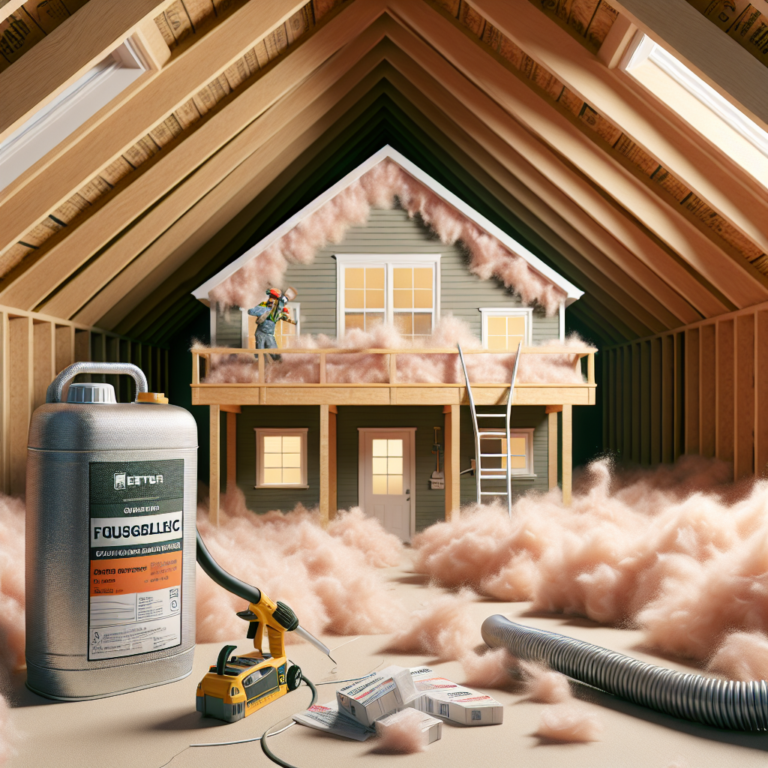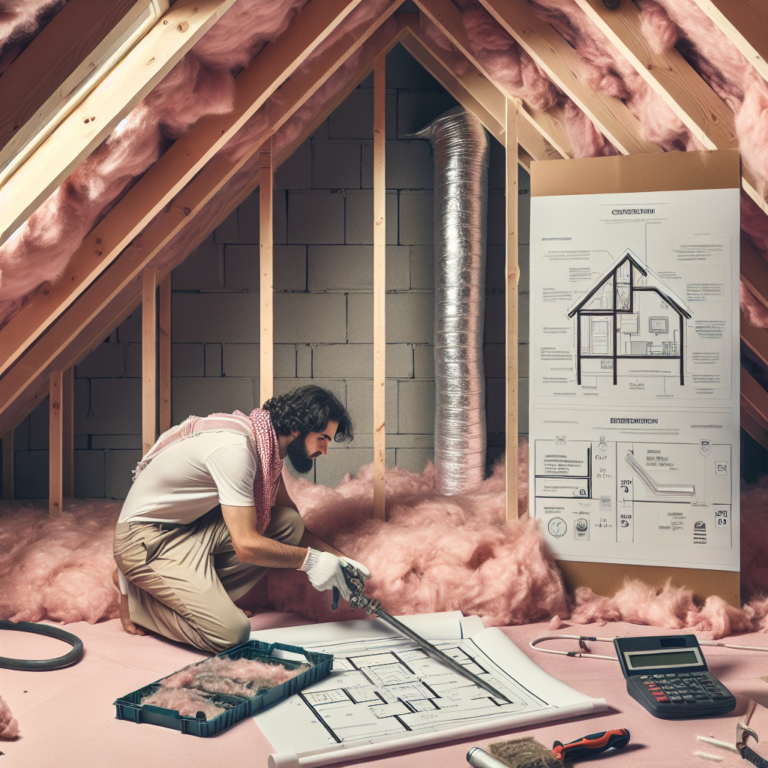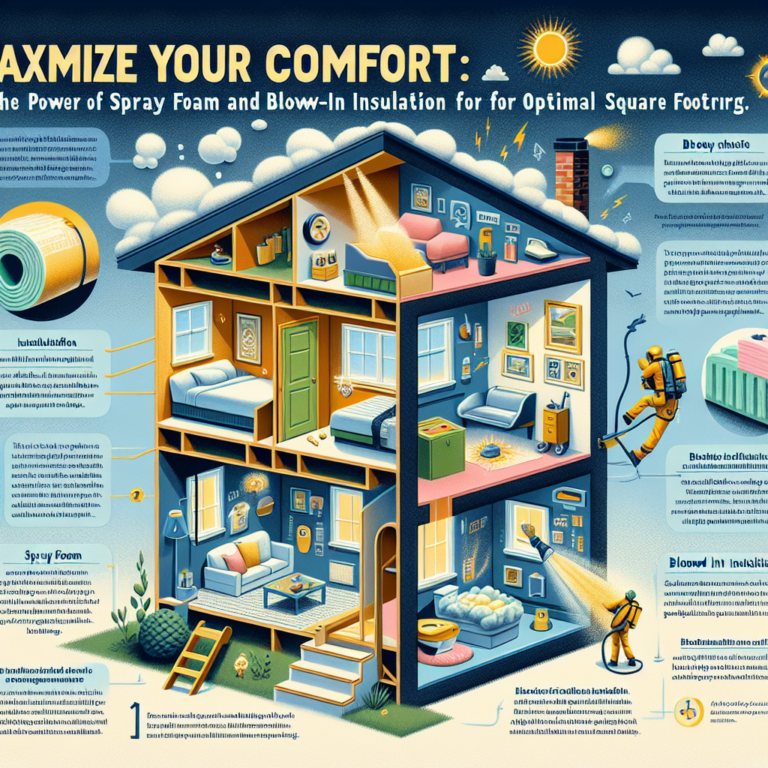Table of Contents
Efficiently insulate your furnace with blown-in insulation – keeping your home warm and your energy bills low.
Introduction
Blown-in insulation around a furnace is a common method used to improve energy efficiency and reduce heating costs in homes. This type of insulation involves using loose, lightweight materials such as fiberglass, cellulose, or mineral wool, which are blown into the spaces around the furnace and other areas of the home. This creates a layer of insulation that helps to trap heat and prevent it from escaping, making the furnace more efficient and reducing the workload on the heating system. In this introduction, we will explore the benefits and process of blown-in insulation around a furnace.
Benefits of Blown-In Insulation Around Furnace
Blown-in insulation is a popular method of insulating homes, and for good reason. It involves using a machine to blow loose insulation material into walls, attics, and other spaces, creating a thick layer of insulation that helps to keep the home warm in the winter and cool in the summer. While blown-in insulation is commonly used in attics and walls, it can also be extremely beneficial when installed around a furnace.
One of the main benefits of blown-in insulation around a furnace is improved energy efficiency. Furnaces are responsible for heating the air in a home, and if there is inadequate insulation around the furnace, a significant amount of heat can escape. This means that the furnace has to work harder and use more energy to maintain a comfortable temperature in the home. By adding blown-in insulation around the furnace, the heat loss is reduced, and the furnace can operate more efficiently, resulting in lower energy bills.
In addition to energy efficiency, blown-in insulation around a furnace can also improve the overall comfort of a home. Without proper insulation, the area around the furnace can become drafty and cold, making it uncomfortable for those living in the home. By adding blown-in insulation, the temperature around the furnace is better regulated, creating a more comfortable environment. This is especially beneficial for those who spend a lot of time near the furnace, such as in a basement or utility room.
Another advantage of blown-in insulation around a furnace is improved air quality. Furnaces can produce a lot of dust and debris, which can circulate throughout the home if there is inadequate insulation. This can lead to allergies and respiratory issues for those living in the home. By adding blown-in insulation, the dust and debris are contained, resulting in cleaner air and a healthier living environment.
Blown-in insulation around a furnace can also help to reduce noise levels in the home. Furnaces can be noisy, especially if they are located in a basement or utility room. The loose insulation material used in blown-in insulation acts as a sound barrier, absorbing and reducing noise levels. This can be particularly beneficial for those who have a furnace located near living spaces, as it can help to create a quieter and more peaceful environment.
Furthermore, blown-in insulation around a furnace can also help to extend the lifespan of the furnace. Furnaces that are constantly working to maintain a comfortable temperature due to inadequate insulation can experience wear and tear, leading to a shorter lifespan. By adding blown-in insulation, the furnace does not have to work as hard, resulting in less strain and potentially extending its lifespan.
Lastly, blown-in insulation around a furnace can also increase the value of a home. With energy efficiency becoming increasingly important to homeowners, having proper insulation, including around the furnace, can be a major selling point. It can also help to make the home more attractive to potential buyers, as it indicates that the home has been well-maintained and is energy-efficient.
In conclusion, blown-in insulation around a furnace offers numerous benefits, including improved energy efficiency, increased comfort, better air quality, reduced noise levels, extended furnace lifespan, and increased home value. It is a cost-effective and efficient way to improve the overall insulation of a home and should be considered by homeowners looking to make their homes more comfortable and energy-efficient.
How to Properly Install Blown-In Insulation Around Furnace

Blown-in insulation is a popular choice for homeowners looking to improve the energy efficiency of their homes. It is a cost-effective and efficient way to insulate walls, attics, and crawl spaces. However, one area that is often overlooked when it comes to insulation is around the furnace. Properly insulating around the furnace can not only improve energy efficiency but also help prevent potential hazards. In this article, we will discuss the importance of insulating around the furnace and provide a step-by-step guide on how to properly install blown-in insulation in this area.
The furnace is the heart of the heating system in a home. It is responsible for heating the air that is circulated throughout the house. However, if the area around the furnace is not properly insulated, it can lead to heat loss and energy waste. This is especially true for older homes where the furnace may be located in an unconditioned space such as the attic or basement. In these cases, insulating around the furnace becomes even more crucial.
The first step in properly insulating around the furnace is to determine the type of insulation that is currently in place. If there is already insulation present, it is important to check its condition. If it is damaged or compressed, it will not be effective in preventing heat loss. In this case, it is best to remove the old insulation and replace it with new blown-in insulation.
Before beginning the installation process, it is important to gather all the necessary materials and tools. These include a utility knife, measuring tape, staple gun, and safety equipment such as gloves, goggles, and a dust mask. It is also important to turn off the furnace and any other electrical equipment in the area to ensure safety during the installation process.
The next step is to prepare the area around the furnace for insulation. This includes sealing any gaps or cracks in the walls or floor using caulk or expanding foam. This will prevent air leakage and ensure that the insulation is effective. It is also important to cover any electrical wires or pipes with insulation to prevent them from being covered by the blown-in insulation.
Once the area is prepared, it is time to install the blown-in insulation. The first layer of insulation should be installed on the floor around the furnace. This will help prevent heat loss through the floor. The insulation should be spread evenly and should be at least 6 inches thick. It is important to avoid compressing the insulation as this will reduce its effectiveness.
The next step is to install insulation on the walls around the furnace. This can be done by using a staple gun to attach the insulation to the walls. It is important to make sure that the insulation is evenly distributed and there are no gaps or spaces between the insulation and the walls. The insulation should be at least 12 inches thick for maximum effectiveness.
After the insulation is installed, it is important to check for any gaps or spaces that may have been missed. These should be filled with additional insulation to ensure that there are no areas where heat can escape. Once the installation is complete, it is important to clean up any excess insulation and dispose of it properly.
In conclusion, properly insulating around the furnace is crucial for improving energy efficiency and preventing potential hazards. By following these steps and using the right materials and tools, homeowners can ensure that their furnace is properly insulated and their home is more energy-efficient. This not only helps save money on energy bills but also contributes to a more comfortable and safe living environment.
Common Mistakes to Avoid When Blowing Insulation into Existing Ceiling
Blowing insulation into an existing ceiling is a popular and effective way to improve the energy efficiency of a home. It involves using a machine to blow loose insulation material into the space between the ceiling and the roof, creating a barrier that helps to keep heat inside during the winter and outside during the summer. While this method can be highly beneficial, there are some common mistakes that homeowners should avoid when undertaking this project.
One of the most common mistakes when blowing insulation into an existing ceiling is not properly preparing the space. Before beginning the process, it is important to clear the area of any debris or obstructions. This includes removing any old insulation, as well as any items stored in the attic space. Failure to properly prepare the space can result in uneven distribution of the insulation, leading to gaps and areas with little to no insulation.
Another mistake to avoid is not using the correct type of insulation for the job. There are various types of insulation available, each with its own unique properties and benefits. When blowing insulation into an existing ceiling, it is important to choose an insulation material that is suitable for this method. Loose-fill insulation, such as fiberglass or cellulose, is typically the best option for this type of project. These materials are designed to be blown into tight spaces and can effectively fill any gaps or voids in the ceiling.
In addition to using the correct type of insulation, it is also important to use the right amount. Too little insulation will not provide adequate coverage and will not effectively improve energy efficiency. On the other hand, using too much insulation can lead to problems such as moisture buildup and reduced ventilation. It is important to carefully calculate the amount of insulation needed for the specific space and follow manufacturer guidelines for installation.
One mistake that is often overlooked is not properly sealing air leaks before blowing in insulation. Air leaks can significantly reduce the effectiveness of insulation, as they allow air to escape and enter the home. Before beginning the insulation process, it is important to seal any gaps or cracks in the ceiling, as well as around light fixtures, vents, and other openings. This will ensure that the insulation can do its job properly and prevent any air leaks from compromising its effectiveness.
Another common mistake is not wearing proper protective gear during the insulation process. Loose-fill insulation materials can be hazardous if inhaled, and it is important to wear a mask and goggles to protect against any particles that may become airborne during installation. It is also important to wear gloves and long sleeves to avoid skin irritation from the insulation material.
Lastly, one of the biggest mistakes to avoid when blowing insulation into an existing ceiling is not hiring a professional. While this may seem like a simple DIY project, it is important to remember that proper installation is crucial for the effectiveness of the insulation. Hiring a professional contractor who is experienced in this type of work can ensure that the insulation is installed correctly and will provide the desired results.
In conclusion, blowing insulation into an existing ceiling can be a great way to improve the energy efficiency of a home. However, it is important to avoid common mistakes such as not properly preparing the space, using the wrong type or amount of insulation, not sealing air leaks, and not wearing proper protective gear. By following these tips and hiring a professional if needed, homeowners can ensure that their blown-in insulation project is a success and provides long-lasting benefits for their home.
Q&A
Q: What is blown in insulation?
A: Blown in insulation is a type of insulation material that is installed by blowing it into an area using specialized equipment. It is commonly used to insulate attics, walls, and other hard-to-reach spaces.
Q: How does blown in insulation work around a furnace?
A: Blown in insulation can be used around a furnace to help prevent heat loss and improve energy efficiency. It is typically blown into the spaces around the furnace, such as the attic or walls, to create a barrier that traps heat and prevents it from escaping.
Q: What are the benefits of using blown in insulation around a furnace?
A: Using blown in insulation around a furnace can help reduce energy costs by improving the overall efficiency of the heating system. It can also help regulate the temperature in the home and reduce noise from the furnace. Additionally, blown in insulation is easy to install and can be a cost-effective option for insulating hard-to-reach areas.
Conclusion
In conclusion, blown in insulation around a furnace is a highly effective way to improve energy efficiency and reduce heating costs. It creates a barrier that prevents heat from escaping and keeps the furnace running more efficiently. Additionally, blown in insulation can also help reduce noise levels and improve indoor air quality. Overall, investing in blown in insulation around a furnace is a smart choice for homeowners looking to save money and improve the comfort of their home.




